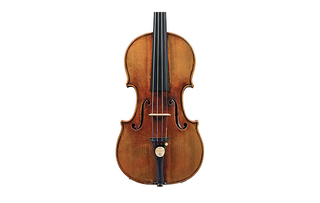Rare Stradivarius Violin Could Fetch $10 Million at Auction

A nearly 300-year-old Stradivarius violin found in the closet of an American copper mining heiress is up for auction this week in New York City.
The precious violin — one of about 650 remaining musical instruments handcrafted by Italian violin maker Antonio Stradivari — could fetch between $7.5 million and $10 million at auction, according to Christie's, the auction house handling the sale.
Stradivari is widely considered one of the greatest violin makers of all time, and instruments built by him and his family in the 1600s and 1700s are thought to be some of the finest quality. [In Images: Recreating a Legendary Stradivarius Violin]
The violin being sold belonged to Huguette M. Clark, the youngest daughter of William A. Clark, a former U.S. senator who made his fortune in the mining, banking and railroad industries.
The violin sat in a closet at Clark's sprawling Fifth Avenue address for 25 years, but before that, it was used extensively by its previous owner, French violinist Rodolphe Kreutzer. The violin's dynamic backstory, beginning in Europe's 18th-century classical music scene, makes the instrument a highly valued piece of musical history.
Kreutzer likely acquired the instrument when he worked as a conductor at a Parisian theater, called the Theatre de Monsieur, representatives at Christie's said. The talented musician, who wrote 19 violin concertos, 40 operas and "42 Etudes ou caprices" — a teaching tool still used for violin performances today — kept the instrument with him his entire life.
The Stradivarius violin, which Christie's representatives said was considered "most special" to the composer, thus came to be known as "the Kreutzer."
Sign up for the Live Science daily newsletter now
Get the world’s most fascinating discoveries delivered straight to your inbox.
More than a century later, the Kreutzer fell into the hands of Clark, who received it as a gift from her parents.
"There is a spectacular telegram that her parents sent her in Paris in 1920 that told her … when they were sailing and when they would be arriving in New York," Kerry Keane, Christie's head musical instrument specialist, told NBC. The telegram said her mother had just bought her daughter "the most fabulous violin in the world," Keane said.
The Clarks were one of the wealthiest families in the Gilded Ageand had a penchant for collecting Stradivarius instruments. Nine Stradivarius instruments were owned at various times by the Clark family: two purchased by Clark's father, and several others collected by Huguette and her mother, including the Paganini Quartet — a valuable set of four string instruments.
As the years passed, Clark became reclusive. She was known for possessing several palatial Manhattan apartments but chose to spend the last decades of her life in a New York hospital. The details of her life were narrated in Bill Dedman and Paul Clark Newell Jr.'s recent book, "Empty Mansions: The Mysterious Life of Huguette Clark," published by Ballantine Books in 2013).
Clark died in 2011 at age 104, and since then, many of her family's possessions have been auctioned off by Christie's. Many of these Gilded Age treasures were retrieved from Clark's 42-room Fifth Avenue apartment — relics that included paintings by Claude Monet and Pierre-Auguste Renoir that sold for a total of $40.9 million earlier this year.
Many replicas of Stradivarius violins exist, and appear to be complete with their names and labels, but experts determined the Kreutzer's authenticity by examining the ring growths found on its wood; the wood matched that of four other Stradivarius violins from the 1730s, meaning that all four were made from the same tree.
Christie's opened the first round of sealed bidding for the Kreutzer on June 6, and the highest bidders from that round will be eligible to make a second offer beginning this Friday (June 13). The highest bidder from the second round will win the violin.
Follow Jillian Rose Lim @jillroselim & Google+. Follow us @livescience, Facebook & Google+. Original article on Live Science.
